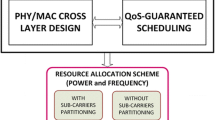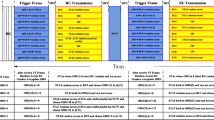Abstract
With the fast growth of Internet services, the demand for wireless high speed and advanced multimedia communications is rapidly increasing. Initial multimedia services have already been offered in the second generation systems (2-G). Currently, the third generation systems (3-G) are being deployed and it will support up to 2 Mbps packet oriented data services. But it is expected that the demand for higher data rate and large variety of high quality services will increase further more. Therefore, it is mandatory for the fourth generation systems (4-G) to take each user's quality of service (QoS) control into account.In this paper, we firstly describe an overview on requirements and technical issues for the 4-G systems, and wireless QoS control issues considering End-to-End QoS control in the IP network. Next, we propose broadband wireless access method for the fourth generation mobile communication systems. The proposed method for downlink is based on MC-CDMA (Multi-Carrier Code Division Multiple Access) with Multi-Timeslot, in which total downlink resources are split into three aggregates according to the QoS classes in time domain. It is considered that one of the typical advantages for the MC-CDMA is the effect of frequency diversity. We evaluated the effect by computer simulation using ray-traced propagation model. Simulation results show that short-term fading can be relaxed. Furthermore, we propose Multi-Level (ML) ARQ as one of the link adaptation methods. Simulation results show that the proposed scheme has a good performance with throughput and average retransmission power.
Similar content being viewed by others
References
Y. Yamao, N. Umeda, T. Otsu and N. Nakajima, “Fourth Generation Mobile Communications System – Issues Regarding Radio Ssytem Technologies –”, IEICE Trans., Vol. J83-B, No. 10, pp. 1364–1373, 2000.
W. Mohr and R. Becher, “Mobile Communications Beyond Third Generation”, IEEE VTC Fall 2000,Sept. 24–28, 2000, Boston, U.S.A., pp. 654–661.
http://www.3gpp.org/
T. Inoue, S. Sampei and N. Morinaga, “A study on High Speed Data Transmission in DS-CDMA and Adaptive Modulation Based TDMA Dual Mode Scheme for Wireless Multimedia Communication Systems”, Technical report of IEICE, RCS2000-188(2001-01), pp. 99–106, 2001, (in Japanese).
S. Abeta, H. Atarashi, M. Sawahashi and F. Adachi, “Coherent Multicarrier/DS-CDMA and MC-CDMA for Broadband Packet Wireless Access”, IEEE VTC Spring 2000, May 15–18, 2000, Tokyo, Japan, pp. 1918–1922.
Ghosh, L. Jalloul, M. Cudak and B. Classon, “Performance of Coded Higher Order Modulation and Hybrid ARQ for Next Generation Cellular CDMA Systems”, IEEE VTC Fall 2000, September 24-28, 2000, Boston, U.S.A., pp. 500–505.
http://www-ihe.etec.uni-karlsruhe.de/forschung/cost231/.
Author information
Authors and Affiliations
Rights and permissions
About this article
Cite this article
Shoji, T., Kato, O. & Uesugi, M. Wireless Access Method to Ensure Each User's QoS in Unpredictable and Various QoS Requirements. Wireless Personal Communications 22, 139–151 (2002). https://doi.org/10.1023/A:1019956104130
Issue Date:
DOI: https://doi.org/10.1023/A:1019956104130




